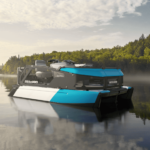If you are planning on buying a boat and have a need for speed, this article is for you! How fast do boats go on average? Below are the average and top speeds for three of the most common types of boats: sailboat, pontoon, and cruiser:
| Type of Boat | Average Speed | Top Speed |
| Sailboat | 8 mph | 12 mph |
| Pontoon | 15mph-30mph | 35 mph |
| Cruiser | 16mph-30mph | 50 mph |
317.6mph (511 km/h) was the fastest boat speed ever recorded. Back in 1978, a speedboat used a jet engine (instead of a propeller) to power the boat.
In decades past, cigarette boats or rum-runners were motorboats designed for fast travel. In flat and calm waters, the slender-shaped boats could sail as fast as 90mph.
This kind of speed is not a typical boat speed. The extra speed element designed for rum-runners was meant to outrun everyone as they carry on their smuggling activities.
Read on to learn the average boat speeds and top boat speeds of sailboats, pontoons, and cruisers.
Also, we hope you find the links here useful. We may get a commission if you purchase something through a link on this page, so thank you!
The Need for Speed
Nothing can fire up the adrenaline more than enjoying a speedy boat ride. Knowing how fast a boat can go is important to know if you are going to use the boat for water activities requiring speed. The activities that require speed include water skiing, tubing, traveling far distances, or simply taking your friends or family for a thrilling fast ride.
A boat pulling a water skier goes at varying speeds from 10mph to 35mph. A 10mph boat speed is considered the best option for beginner water skiers. The higher speed of 35mph is best used for experienced water skiers involved in water activities such as jumps or slaloms.
The varying speeds make us see that the action is the determinant for average boat speeds. A boat with a top speed of 15mph is great if you want to cruise along calm waters.
The key is to strike a balance between fuel efficiency and speed. A faster boat generally will use more fuel than a slower boat. So just keep that in mind if you are planning on buying a fast boat.
Click here to see this First Aid Kit on Amazon.
Boat Speed Factors
The hull type and length are the most important determinants of boat speed. A boat is liable to travel faster when less part of its body is submerged in water. A longer boat is a faster boat.
Below, I’ll describe three of the key factors that determine boat speed, including:
- Boat Length
- Wind Speed and Direction
- Hull Type
Boat Length
The length of the boat is a key factor in hull speed. A longer boat is a faster boat. That’s the rule of thumb for boats.
Different boat lengths showing their maximum hull speeds are as follows:
| Length | Meters | KMH | MPH | Knots |
| 16 feet | 5 meters | 9.3 | 5.8 | 5 |
| 26 feet | 8 meters | 12.6 | 7.8 | 6.8 |
| 36 feet | 11 meters | 14.8 | 9.2 | 8 |
| 40 feet | 12 meters | 15.7 | 9.8 | 8.5 |
| 65 feet | 20 meters | 20 | 12.4 | 10.8 |
| 80 feet | 24 meters | 22.2 | 13.8 | 12 |
| 100 feet | 30 meters | 24.8 | 15.4 | 13.4 |
Wind Speed and Direction
Wind speed and direction is another key factor that determines your average boat speed. This is especially important for sailboats, of course. You need to check these factors if you plan to make an ocean journey in a sailboat. Also, you want a favorable current and want to be downwind as much as possible when sailing.
Hull Type
A monohull or a displacement hull in a sailboat will enable it to travel the standard speeds between 4.5mph-7mph or 4-6 knots. However, using a planing hull will make it ride like the wind at unbelievable speeds between 35-58mph or 30-50 knots or 55-92kmh. The planing hulls in racing sailboats are a key reason for their incredible speeds.
Click here to see this O’Neill Men’s Superlite USCG Life Vest on Amazon.
Average and Top Boat Speeds for a Sailboat, Cruiser, and Pontoon
| Type of Boat | Average Speed | Top Speed |
| Sailboat | 8 mph | 12 mph |
| Pontoon | 15mph-30mph | 35 mph |
| Cruiser | 16mph-30mph | 50 mph |
Average Boat Speed of a Sailboat
The practice of harnessing the wind is a central skill for moving a sailboat fast. A sailboat’s average cruising speed ranges from 8mph to 12mph. However, sailboats are also capable of higher speeds, such as the breakneck world record speed of over 75mph in 2012.
How fast did early sailboats go? It has been recorded that ships sailing during the 15th century, like Columbus’ ship, had an average cruising speed of 4 knots, with its top speed being 8 knots. Converted into miles, that sailing speed would range between 4pmh and 9mph.
Check out this sailboat speed record done in 2012:
Average Boat Speed of a Pontoon Boat
A pontoon boat is more than just a relaxing ride on a lake – it is capable of reaching very fast speeds.
Under the right circumstances, a pontoon is capable of moving at more than 30mph. It can even achieve a speed of 35mph if a pontoon has a larger engine and the conditions are right.
For instance, a pontoon with a 90HP motor can easily move at more than 30mph. Putting a 60HP engine with a 20-foot pontoon can only achieve a speed of about 15mph.
On the other hand, placing a 90HP engine on a pontoon can make it move at the top speed of about 25mph, even when weighed down with a few passengers.
Here is a pontoon boat going much faster than they usually go:
Average Boat Speed of a Cruiser
The affordable price range of cruiser-style motorboats makes it the top boat for families in the United States.
The slowest cruising speed for a cruiser is around 16mph. However, the remarkable thing about cruisers is their fuel efficiency. When moving at moderate speeds, the cruiser can go more than 800 miles without having to stop to refuel.
A sport fisher is a speedier type of cruiser. It has been known to come close to top speeds of about 50mph and a comfortable cruising speed around 30mph.
A larger motorboat is the best option to go for when trips take several days to travel. Bigger cruisers comfortably travel at around 30mph.
Click here to see this GearLight Flashlight 2pk Bright on Amazon.
Fuel Use for Standard Boat Speeds
Traveling fast in a motorboat is always thrilling and fun. However, the fuel expense can also burn a hole in your pocket.
For instance, a 24-foot speedboat maintaining a cruising speed of 7mph will consume around 3 gallons of fuel per hour. Traveling at a faster cruising speed of 15mph will now consume 7 gallons per hour.
Double that speed to 30mph, and the fuel consumption will rise to 11 gallons per hour! Notwithstanding, 24-foot motorboats are capable of running at speeds of more than 45mph.
Some fuel-efficient powerboat models have addressed the fuel consumption issue with motorboats. With these kinds of motorboat models, cruising at enjoyable speeds still conserves fuel.
Boat Speed Laws
You know the allowed speed limit when driving on the road. The speed limit is usually posted at the side of the road. However, it is a bit trickier to determine speed regulation for boats.
Beaches and waterfronts do not post speed limits for boats. This is because a lot of factors can change the speed limit. Factors include the type of boat, time, type of waterway, and more.
Sailing in the open water of an ocean, a big lake or sea that presents a clear view ahead of you can allow you to speed up your boat. But you have to move at a more cautious speed when traveling close to a bay, shore, or river.
The “No Wake Zone” is the sign you have to watch out for. This sign is usually posted near the shore, docks, canals, and marinas. Seeing this sign means that a boat should travel slowly. A swell can threaten swimmers, other boaters, animals, and more.
Using a speed of more than 5mph can produce a noticeable wake. This means that you have to be extra careful with the speeds you use in “No Wake Zone” areas.
This is a good rule that looks out for the safety of all people out on the water.
Conclusion – Average Boat Speeds: Sailboat, Pontoon, Cruiser
What is the average boat speed for a sailboat, pontoon, and cruiser:
| Type of Boat | Average Speed | Top Speed |
| Sailboat | 8 mph | 12 mph |
| Pontoon | 15mph-30mph | 35 mph |
| Cruiser | 16mph-30mph | 50 mph |
Different types of boats reach different speeds. Many factors can affect speed, such as current and wind conditions. The length of the boat can also affect the boat’s speed. A faster speed is with the larger-sized boats.
When it comes to long journeys, the first thing that boaters want to know is the boat’s average speed. Purpose and size are the top factors that influence a boat’s speed. Bulkier and larger ships plod more slowly than the specifically sleek designs of the racing sailboats.
As mentioned, the longer the length of the boat, the faster it will go. The wind and the hull type are other big boat speed factors. With that said, enjoy going fast on the water, but remember to put safety first.
Related reading:
What Is the Best Stainless Steel Propeller?
Types of Boats – Full List of 20 Different Types














![Amel Sailboat Review [50, 60, Super Maramu, Kirk] amel sailboats](https://boatinggeeks.com/wp-content/uploads/2021/06/amel-sailboats-150x150.jpg)



![Read more about the article Boat Floor Replacement Plywood [Best Options]](https://boatinggeeks.com/wp-content/uploads/2021/07/boat-floor-replacement-plywood-300x200.jpg)

![Read more about the article Spot-Lock Trolling Motor [What Is It? and Best Spot-Lock Motors]](https://boatinggeeks.com/wp-content/uploads/2021/06/spot-lock-trolling-motor-300x200.jpg)